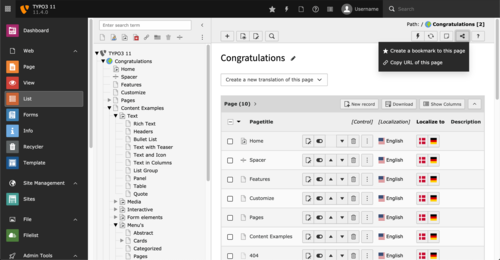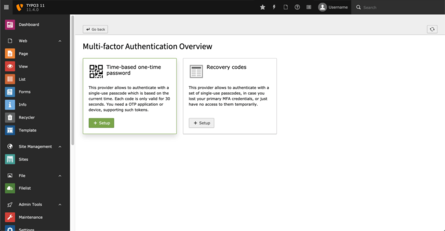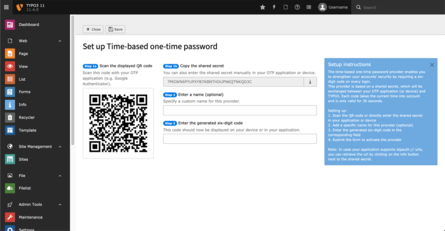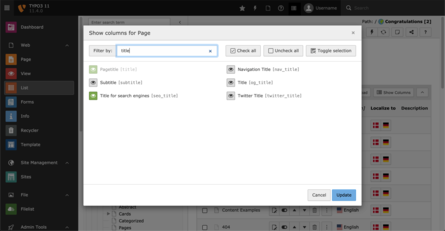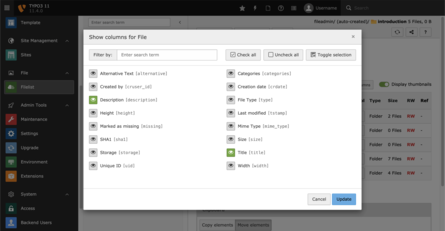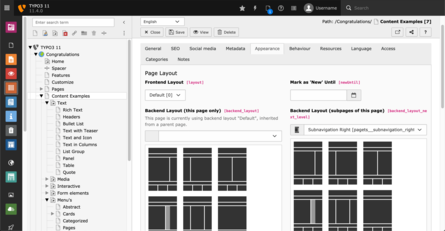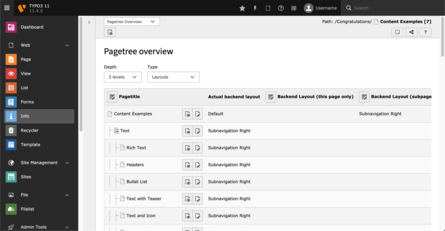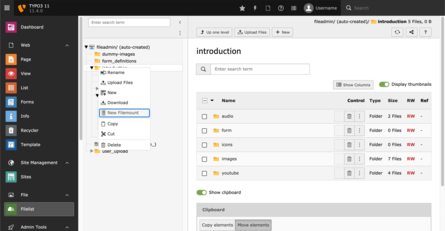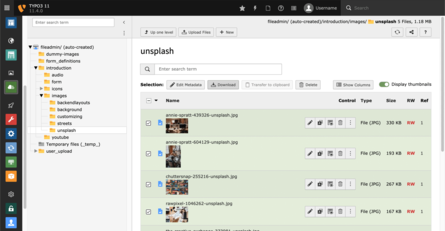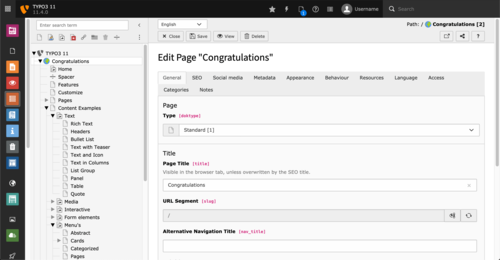Share functionality for the TYPO3 backend
Backend URLs now are human-readable, and even better: you can share them! A new "Copy URL" button was added in many backend modules, content elements, and other records. You can use it to copy the current link and share it with your colleagues:
- Opens the content element with ID 131:
www.example.org/typo3/record/ edit?edit[tt_content][131]=edit - Opens the page with ID 91:
www.example.org/typo3/record/ edit?edit[pages][91]=edit - Opens the Info module, showing the SEO fields in the Pagetree overview:
www.example.org/typo3/module/ web/info?id=91&SET[pages]=seo
If a user is not logged in at the time, the login page is shown. After successful login, the user is redirected to the original link. Of course, access rights cannot be bypassed with this.
This feature can significantly improve the work between editors as well as customer support.
The .htaccess must be updated for the new backend routing to work! If your file does not differ much from the original, this can occur automatically during the upgrade process. You can also find the necessary change in the Changelog.
Multi-Factor Authentication
The backend login can now be protected by an additional measure. The TYPO3 core ships with the commonly used "Time-based One-time Password" (TOTP): You can connect an App such as Google Authenticator, Microsoft Authenticator, or 1Password via QR code. The App will then generate a new, synchronized token every 30 seconds.
Every user can set up Multi-factor authentication in their User settings.
Further MFA providers are available in the TYPO3 Extension Repository. It is recommended to always add the "Recovery Codes" provider as a fallback.
You can configure MFA to be mandatory for editors, admins, system maintainers, or all users. It's best to have a look at the changelog entry, which explains all available configuration options ($GLOBALS['TYPO3_CONF_VARS'] and User TSconfig) in detail.
User Experience in the backend
The primary goal of this TYPO3 release was to improve the backend for editors and integrators alike. Or, as Benni Mack (TYPO3 Core Project Lead) called it at the TYPO3 Usergroup Lake Constance: "We're making things better that have been bugging people about TYPO3 for a long time."
Besides some new features, many minor improvements will make daily work easier. The following is just a personal selection.
"Show columns" in Web>List and Filelist
Most of you will be familiar with the Single Table View in the List module, even though it is quite hidden. Here there has long been the possibility to show and hide additional fields of the table.
From now on, the "Show columns" button is available in the regular list view, which makes this feature easily accessible. Via Page TSconfig, the button can be hidden for individual or all tables if required:
// Disable the column selector for system categories:
mod.web_list.table.sys_category.displayColumnSelector = 0
// Disable the column selector for all tables:
mod.web_list.displayColumnSelector = 0The Single Table View remains unchanged! You can still use it to edit selected fields of several records at the same time.
Improved page tree
- Variable width: In TYPO3 v11, the width can again be adjusted as needed. The last defined width is saved - even for future logins and when switching browsers.
- Collapse all page trees with a corresponding button. This can be quite useful for larger page structures.
- Page filter and selection of new page types are now displayed among one another.
Useful hints and small features
Helpful field descriptions for records
The property description in the TCA exists since TYPO3 v9. You can use it to add a hint text for editors to a field. I find this quite useful to explain certain features briefly.
With TYPO3 v11, this description can now be set (or overwritten) with Page TSconfig. This also works for selected record types, e.g. for content elements:
// Global description of a field with monolingual label:
TCEFORM.pages.title.description = Visible in the browser tab, unless overwritten by the SEO title.
// Description of the header field only for CType "textmedia", using a localization file:
TCEFORM.tt_content.header.types.textmedia.description = LLL:EXT:my_sitepackage/Resources/Private/Language/locallang.xlf:textmedia.header.descriptionPrevent mistakes when setting up editor rights
You want to properly set up the TYPO3 backend for your editors. And when it comes to assigning access rights, one or two stumbling blocks are waiting for you.
For instance, write permissions for the colPos of content elements and the slug field of the pages are important. An example: If an editor is missing the rights for the slug field, all new subpages will be created by him with an empty slug. If you try to open these pages, the homepage will be called instead.
To prevent this, the fields tt_content.colPos and pages.slug are no longer configured as exclude fields in TYPO3 v11. This means: the editor always has access to them.
However, these fields can still be hidden via page TSconfig. This makes them invisible for the editor without affecting the functionality.
What else?
We finally say goodbye to the outdated, Marker-based templating. The cObject TEMPLATE has been removed from the TYPO3 core. ###FAREWELL##!
A lot has happened under the hood with Workspaces. I always found the staging possibilities a neat feature and unique selling point of TYPO3. Unfortunately, Workspaces had its quirks in the past, so it was rarely used in my projects. In TYPO3 11, it may be worth trying the feature again.
Some new configurations were added: Data processors and conditions, an excludePagesRecursive option for the XML sitemaps, …
It is, therefore, worthwhile to have a look at the official "What's New" slides. You can find a complete overview with further information in the TYPO3 changelog.
If you're a programmer using Extbase, I can recommend the current article on usetypo3.com. The application framework was modernized in several aspects, making adjustments necessary in custom extensions.
A big thank you to everyone involved!
"... goes to eleven" is, of course, a reference to the guitar amp of Spinal Tap's guitar legend Nigel Tufnel.
